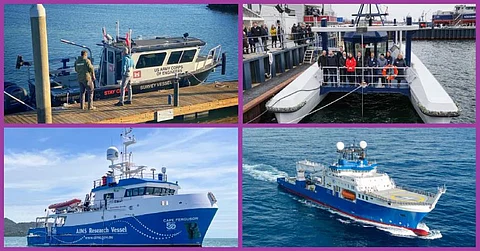

A German university christens an autonomous catamaran demonstrator as two US-based owners welcome recently acquired vessels to their respective fleets. An Australian government operator places an order for a more capable research vessel to be designed in collaboration with an American engineering firm.
German-designed autonomous demonstrator catamaran formally named
The Kiel University of Applied Sciences in Germany has formally named a new autonomous research demonstrator vessel built by local shipyard Gebruder Friedrich.
Named Wavelab, the catamaran vessel is being developed by a consortium of five German organisations with the aim of gauging the feasibility of incorporating autonomous navigation technology on passenger ships.
The vessel will initially be operated from a shore-based control centre. Data collected during trials will be transmitted from the vessel to the control centre via WLAN.
Schmidt Ocean Institute places refurbished platform supply vessel into service
California-based research organisation Schmidt Ocean Institute recently welcomed a rebuilt research vessel into operational service.
The 110-metre Falkor (Too) is the former Polar Queen, which was originally built as a platform supply vessel in 2011. It will replace an older vessel in the institute's fleet and will be made available to scientists worldwide wishing to expand their respective deep sea research activities.
Upgrades to the vessel include a 105-square-metre main laboratory, seven smaller laboratories, a 150-tonne crane, two moonpools, high-resolution ocean mapping equipment, and a 900-square-metre aft deck for interdisciplinary ocean research and exploration.
The refit works on Falkor (Too) were carried out at Spain's Freire Shipyard, which had also built the vessel in 2011.
New survey boat delivered to US Army Corps of Engineers
North River Boats of Oregon has delivered a new aluminium-hulled survey boat to the US Army Corps of Engineers.
The 26-foot (7.92-metre) boat is fitted with a side-mounted sonar arm for deploying survey equipment as an alternative to an integrated moonpool.
The vessel's survey equipment includes LIDAR and a multi-beam echosounder. Surveys will be performed in support of dredging, inspection, and infrastructure improvement projects.
Consortium to design new research vessel for Australian science institute
The Australian Institute of Marine Science (AIMS) has appointed a consortium that includes Sydney-based One2Three Naval Architects and US engineering firm Glosten to design a new research vessel.
The newbuilding will replace Cape Ferguson (pictured), which entered service with AIMS in 2000.
The newer vessel will boast a larger work deck, room for additional scientists, and the ability to act as a multi-technology and sensor platform, coordinating a range of autonomous systems. The design consortium will produce three concepts for consideration by AIMS, including multi-hulled options.
